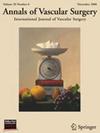Utility of Psoas Muscle Index as Predictor of Worse Outcomes Following Major Amputation from Peripheral Vascular Disease
IF 1.4
4区 医学
Q3 PERIPHERAL VASCULAR DISEASE
引用次数: 0
Abstract
Background
Frailty has been reported as a predictor of adverse outcomes after various surgical procedures. There are several models for defining frailty, including 5-factor modified frailty index, clinical frailty scale, and psoas muscle index. Low psoas muscle index has been associated with higher postoperative mortality and complications after various surgical procedures. Our objective was to assess psoas muscle index as a predictor of outcomes after major amputation in patients with peripheral vascular disease.
Methods
We performed retrospective chart review of patients with peripheral vascular disease who underwent major amputation at a safety-net hospital from 2016 to 2022. Psoas index was evaluated based on computed tomography scans within 6 months of amputation. Outcomes included postoperative 30-day mortality, wound complications, respiratory complications, cardiac complications, and 1-year mortality. Psoas muscle index was calculated using psoas muscle area measured from computed tomography scans at the level of the L4 vertebral body divided by the body surface area. Univariate and multivariate analysis was used to compare postoperative outcomes by gender and by psoas muscle index.
Results
A total of 106 patients were analyzed (68 males, 38 females). Females had higher rates of above-knee amputation (AKA) compared to males (55.2% vs. 27.9%, P = 0.04). Males had a significantly higher baseline mean psoas muscle index compared to females (1,088 mm2/m2 vs. 787 mm2/m2, P < 0.01). AKA within 30 days (20% vs. 10.8%, P = 0.05) and respiratory complications (9.5% vs. 1.2%, P = 0.04) were more likely in patients with low psoas muscle index compared to those with high psoas muscle index when low psoas muscle index was defined as the lowest 20th percentile of patients. Females with a low psoas muscle index were more likely to have wound complications (60% vs. 21%, P = 0.03). Females were more likely to require AKA within 30 days after below knee amputation (19.4% vs. 9%, P = 0.02) and have a higher rate of mortality at 1 year (45.8% vs. 23.1%, P = 0.04) compared to males regardless of psoas index.
Conclusions
Our results demonstrate that low psoas muscle index is associated with worse outcomes after major amputation for peripheral vascular disease, particularly in female patients. These data may be helpful for preoperative risk assessment and decision-making regarding amputation level.
腰肌指数作为外周血管疾病截肢后不良预后预测指标的应用
背景:虚弱已被报道为各种外科手术后不良结果的预测因子。有几种定义虚弱的模型,包括五因素修正的虚弱指数、临床虚弱量表和腰肌指数。腰大肌指数低与各种外科手术后较高的术后死亡率和并发症有关。我们的目的是评估腰肌指数作为周围血管疾病患者截肢后预后的预测指标。方法:我们对2016-2022年在安全网医院接受大截肢手术的外周血管疾病患者进行回顾性图表回顾。术后6个月内通过CT检查评估腰肌指数。结果包括术后30天死亡率、伤口并发症、呼吸并发症、心脏并发症和1年死亡率。腰大肌指数通过腰大肌面积除以体表面积计算。腰大肌面积是通过CT扫描在L4椎体水平测量得到的。采用单因素和多因素分析比较不同性别和腰肌指数的术后结果。结果:共分析106例患者,其中男68例,女38例。女性的AKA发生率高于男性(55.2% vs 27.9%, p=0.04)。男性的基线平均腰肌指数明显高于女性(1088 mm2/m2比787 mm2/m2,患者的第p百分位数)。腰大肌指数低的女性更容易出现伤口并发症(60% vs 21%, p=0.03)。与男性相比,无论腰大肌指数如何,女性在BKA后30天内更有可能需要AKA(19.4%对9%,p=0.02), 1年后的死亡率更高(45.8%对23.1%,p= 0.04)。结论:我们的研究结果表明,腰大肌指数低与周围血管疾病大截肢术后较差的预后相关,尤其是女性患者。这些数据可能有助于术前风险评估和截肢水平的决策。
本文章由计算机程序翻译,如有差异,请以英文原文为准。
求助全文
约1分钟内获得全文
求助全文
来源期刊
CiteScore
3.00
自引率
13.30%
发文量
603
审稿时长
50 days
期刊介绍:
Annals of Vascular Surgery, published eight times a year, invites original manuscripts reporting clinical and experimental work in vascular surgery for peer review. Articles may be submitted for the following sections of the journal:
Clinical Research (reports of clinical series, new drug or medical device trials)
Basic Science Research (new investigations, experimental work)
Case Reports (reports on a limited series of patients)
General Reviews (scholarly review of the existing literature on a relevant topic)
Developments in Endovascular and Endoscopic Surgery
Selected Techniques (technical maneuvers)
Historical Notes (interesting vignettes from the early days of vascular surgery)
Editorials/Correspondence

 求助内容:
求助内容: 应助结果提醒方式:
应助结果提醒方式:


